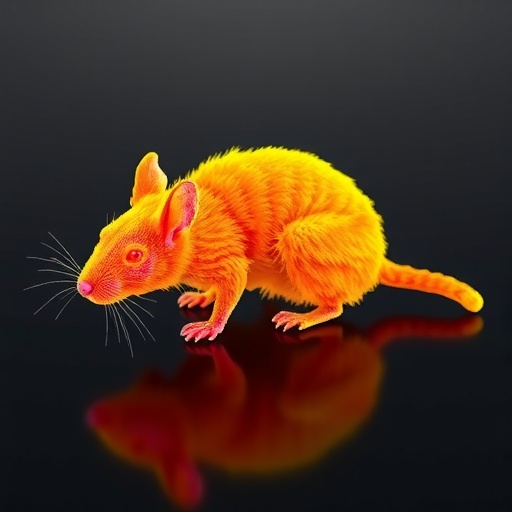
In a groundbreaking advancement for neuroscience, researchers have unveiled a mouse brain stereotaxic topographic atlas with an unprecedented isotropic 1-micron resolution, promising to revolutionize spatial mapping within the mammalian brain. This new atlas, developed through meticulous identification of intracranial anatomical landmarks and innovative imaging techniques, bridges traditional skull-based coordinate systems with modern imaging modalities, opening fresh avenues for integrative neuroanatomical studies.
At the heart of this innovation lies the precise establishment of intracranial datum marks—critical anatomical reference points used to navigate the complex three-dimensional structure of the mouse brain. The team selected eight distinct and reliably identifiable structures from the MOST-Nissl dataset, including the anterior commissure, nucleus ambiguous, corpus callosum, dentate gyrus granular layer, dorsal raphe, lateral amygdalar nucleus, medial geniculate complex, and the facial nerve (VIIn). These structures were chosen for their distinct cytoarchitectural features, allowing neuroanatomists to pinpoint their geometric centers and endpoints, culminating in a set of 18 highly reproducible coordinate points within the intracranial space.
The rationale behind selecting these specific intracranial landmarks extended across all three anatomical planes—anterior-posterior, left-right, and superior-inferior—ensuring comprehensive brain coverage. Established expertly by neuroanatomists through meticulous analysis of high-resolution cytoarchitecture images from three orthogonal orientations, these datum marks serve as a stable, detailed scaffold upon which the entirety of the brain’s spatial architecture can be mapped.
.adsslot_64Ea5WdUDp{width:728px !important;height:90px !important;}
@media(max-width:1199px){ .adsslot_64Ea5WdUDp{width:468px !important;height:60px !important;}
}
@media(max-width:767px){ .adsslot_64Ea5WdUDp{width:320px !important;height:50px !important;}
}
ADVERTISEMENT
To translate these intricate intracranial data points into a framework compatible with traditional skull-based stereotaxic coordinates, the researchers employed a fluorescent MOST (fMOST) imaging technique. By staining the mouse head with propidium iodide, they generated a volumetric 3D dataset capturing both the cranial bone and underlying brain tissue. This hybrid imaging allowed for unprecedented visualization of cranial landmarks, including the bregma and lambda points, at submicron horizontal resolution of 0.325 μm per pixel and axial resolution of 1 μm per pixel.
Critical to this process was the extraction and alignment of the cranial cavity contour from the fMOST dataset with the brain’s contour from the MOST-Nissl data. This alignment established a spatial correspondence between cranial and intracranial datum marks, effectively linking the external skull-based stereotaxic coordinates—which have been the mainstay in neuroscience for decades—to the intricate internal architecture of the brain. This achievement addresses a longstanding challenge in neuroanatomy: accurately mapping deep brain structures in relation to externally visible skull landmarks.
One of the most powerful aspects of this stereotaxic topographic atlas model (STAM) lies in the strategic distribution of its datum marks across the brain. Because several of these marks are identifiable not only in optical imaging modalities but also in techniques like magnetic resonance imaging (MRI) and immunohistochemistry, they function as cross-modal landmarks. This feature empowers scientists to spatially integrate partial or non-whole-brain datasets with various imaging approaches, thereby enhancing comparative studies and multi-scale brain mapping.
Looking beyond the mouse brain alone, the researchers established a spatial mapping relationship linking STAM with the Waxholm Space (WHS), a widely used MRI-based brain atlas. This integration signifies a major step toward unifying disparate neuroimaging datasets under a common stereotaxic framework, facilitating seamless data sharing and comparative analysis across laboratories worldwide. The WHS compatibility means that anyone using MRI for mouse brain imaging can now reference this new high-resolution anatomo-topographic atlas, improving localization accuracy dramatically.
The profound level of resolution and spatial precision achieved with the STAM dataset cannot be overstated. Achieving isotropic spatial resolution at the scale of one micron allows for visualization and mapping of microstructural features across the entire mouse brain in three dimensions. This isotropy is critical; it ensures that spatial resolution is uniform along all axes, enabling high-fidelity reconstruction and spatial analysis without distortion or bias introduced by anisotropic imaging resolutions common in many existing methods.
Such a detailed and spatially consistent atlas is expected to accelerate research into neural circuit organization, neurodevelopment, and neuropathology by providing an ultra-high-definition reference framework. Experimental results derived from specific brain regions can now be precisely located and contextualized within the global brain architecture, improving reproducibility and collaborative studies.
Moreover, the methodology of combining fluorescent labeling, automated serial sectioning, and stitching of volumetric datasets sets a new technical standard in anatomical imaging. By leveraging fMOST alongside cytoarchitectural staining, the team generated a multimodal composite that addresses the inherent limitations of single-modality techniques. For example, while traditional Nissl staining excels in defining cytoarchitecture, it lacks the ability to visualize bony landmarks necessary for stereotaxic referencing. The dual dataset approach solves this by correlating intracranial features visible in Nissl staining with external cranial landmarks visible in propidium iodide fluorescence.
This integrated solution also enhances the accuracy of stereotaxic surgery, neural tracing, and in vivo imaging experiments where precise localization within the brain is vital. Researchers can now employ this refined atlas to define injection sites, electrode placements, or imaging focal zones with unmatched anatomical precision, advancing experimental neuroscience to unprecedented heights.
The interdisciplinary collaboration demonstrated in this work underscores the importance of combining neuroanatomical expertise, advanced imaging technology, and computational alignment techniques to solve complex spatial mapping challenges. The neuroanatomists’ painstaking delineation of anatomical landmarks ensured biological relevance and accuracy, while the imaging scientists’ mastery of high-resolution fMOST facilitated comprehensive data acquisition. Computational tools then seamlessly unified these datasets, illustrating a new paradigm for brain atlas construction.
In the broader scope of neuroscience research, this atlas offers an essential resource compatible with emerging technologies such as optogenetics, single-cell transcriptomics, and connectomics. It paves the way for integrating molecular, cellular, and circuit-level data into a unified spatial framework, facilitating deeper understanding of brain function and dysfunction.
Ultimately, the release of this mouse brain stereotaxic topographic atlas marks a pivotal milestone. It heralds the arrival of neuroanatomical mapping with micron-level fidelity, bridging classical stereotaxic practices with the cutting edge of multi-modality imaging. This breakthrough will likely catalyze novel discoveries in brain organization, disease mechanisms, and therapeutic interventions by offering a definitive spatial vocabulary shared across imaging platforms.
As neuroscientists worldwide begin adopting this atlas, it will serve as the spatial backbone connecting diverse datasets, experimental results, and imaging modalities. Such a universal platform holds promise for accelerating convergence in brain research, fostering collaboration, and cultivating a deeper understanding of the mammalian brain’s intricate landscape.
Subject of Research: Mouse brain stereotaxic topographic atlas development and spatial mapping techniques
Article Title: A mouse brain stereotaxic topographic atlas with isotropic 1-μm resolution
Article References:
Feng, Z., Li, X., Luo, Y. et al. A mouse brain stereotaxic topographic atlas with isotropic 1-μm resolution. Nature (2025). https://doi.org/10.1038/s41586-025-09211-8
Image Credits: AI Generated
Tags: 1-micron isotropic resolutionanatomical reference pointscytoarchitectural featureshigh-resolution imaging techniquesintracranial anatomical landmarksmammalian brain researchmost-nissl datasetmouse brain atlasneuroanatomical mappingneuroanatomical studiesstereotaxic topographic atlasthree-dimensional brain structure





